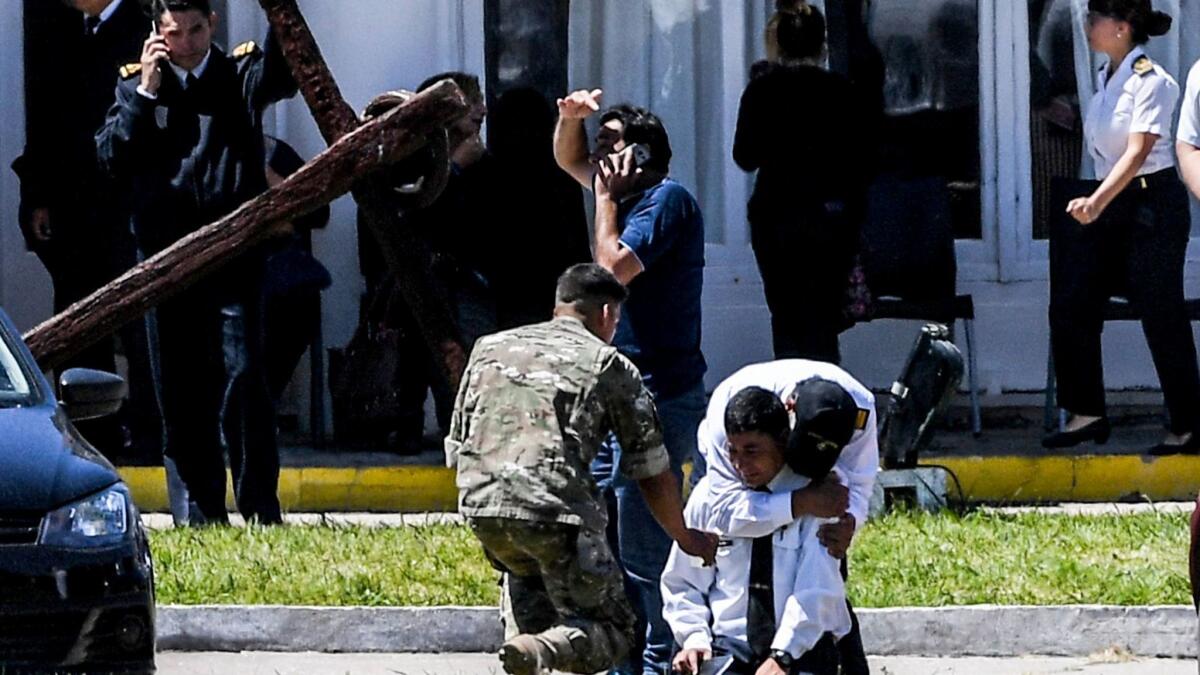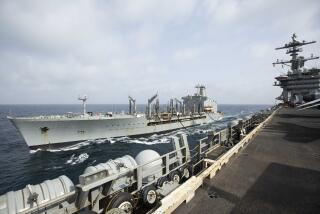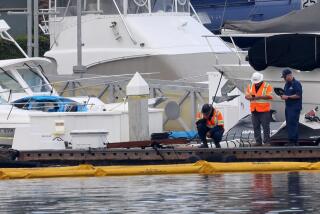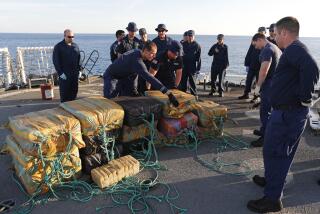Argentina says missing submarine suffered explosion but doesn’t know the crew’s fate

- Share via
Reporting from BUENOS AIRES — An international flotilla of ships and several high-tech aircraft searching for a missing Argentine submarine focused on an area in the southern Atlantic Ocean on Thursday after authorities confirmed acoustical evidence of an explosion coming from the lost vessel with 44 crew members aboard.
The Argentine navy confirmed Thursday that its missing submarine, the San Juan, experienced an explosion Nov. 15, three hours after Capt. Pedro Fernandez called to report a power system failure. The data also pinpointed the site of the explosion as close to the point of last contact.
But Argentine navy spokesman Capt. Enrique Balbi had no information on the fate of the 44 crew members. Nor has the submarine been located, as no trace including wreckage has turned up yet.
“There was an anomalous event [which was] unusual, short, violent and nonnuclear, consistent with an explosion,” Balbi said at a news conference in Buenos Aires, the capital.
Assuming that the submarine remained intact after the blast and is resting on the ocean floor, the ship had only a seven-day supply of oxygen, which may have run out Wednesday. Also complicating a rescue are the ocean depths ranging from 600 to 9,000 feet in the area of the explosion.
The blast occurred in waters 240 miles east of the Valdes Peninsula in Argentina’s Chubut province. The explosion was detected less than 40 miles from where Fernandez, the submarine’s captain, last communicated with onshore authorities and mentioned problems with the ship’s battery system.
Balbi explained the delay in the announcement by saying that only on Wednesday did his government receive confirmation of the explosion from the U.S. Navy, which received and analyzed the data collected from its sonar technology. Separate confirmation came Thursday morning from an Austrian-based agency that monitors for violations of the global ban on nuclear testing.
Family members, who said they were told the news shortly before the Thursday morning news conference, said they were enraged by the Argentine navy’s handling of the information.
“Now there is no hope. We are furious. They are shameless,” said Itati Leguizamon, wife of the submarine’s radar specialist German Oscar Suarez, speaking of navy officials. She spoke to reporters at the entrance of the Mar del Plata naval station, about 250 miles south of Buenos Aires. “They lied to us. How are they not going to know [before now] that there was an explosion.”
Maria Rosa Belcastro, mother of crew member Lt. Fernando Vicente Villareal, told TN news cable channel that since hearing of the explosion, she has lost all hope of seeing her 38-year-old son, who is married and has a 3-year-old daughter. “I believe my son will not be returning.”
Both the U.S. and Austrian reports placed the location of the explosion in roughly the same area.
The U.S. Navy has dispatched two specialized aircraft capable of detecting submarines below or above the ocean surface, as well as specialized manned and unmanned underwater vehicles capable of cutting into the submarine and extracting the crew.
The submarine disappeared as it cruised from Ushuaia in Argentina’s southern extremity toward the Mar del Plata naval base. The disappearance prompted assistance from 13 nations, including Russia, Britain, Peru, Brazil and France in addition to the U.S.
Despite diminishing odds, the search party, which is being led by Argentine and U.S. Navy search-and-rescue specialists and includes assets lent by a dozen other nations, remains focused on finding the sub and crew, said U.S. Navy Cmdr. Erik Reynolds, spokesman for the Southern Command at Naval Station Mayport in Jacksonville, Fla.
“We are still in a search-and-rescue mode and going on the premise we will find sailors and rescue them,” Reynolds said. “As time goes on, it’s getting harder after eight days since the last contact, but everyone is working with hope and as much optimism as they can.”
In addition to the two P-8 Poseidon submarine-hunting aircraft, the U.S. also lent two manned underwater rescue vehicles, one of which can descend to depths of 2,000 feet to rescue as many as 16 people at a time, Reynolds said.
The Navy has also sent four unmanned underwater search units capable of using sophisticated sonar technology to locate underwater “anomalies” including submarines. Reynolds said 200 U.S. Navy personnel are involved in the search, which is headquartered in the coastal city of Comodoro Rivadavia in Argentina’s Patagonia region.
The Navy research vessel Atlantis, which serves as a support vessel for underwater operations and which is outfitted with heavy cranes, is also in the area.
Special correspondents D’Alessandro and Kraul reported from Buenos Aires and Bogota, Colombia, respectively.
UPDATES:
4:45 p.m.: This article was updated throughout with additional details.
This article was originally published at 9:30 a.m.
More to Read
Sign up for Essential California
The most important California stories and recommendations in your inbox every morning.
You may occasionally receive promotional content from the Los Angeles Times.










